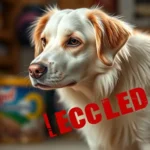
Introduction
Nutrition plays a crucial role in maintaining a dog’s overall health, impacting everything from energy levels to coat condition. One of the most debated topics among pet owners is whether dogs can thrive on a diet comprised solely of dry food, commonly known as kibble. This article aims to provide a comprehensive understanding of dog nutrition, specifically addressing the implications of a dry food-only diet.
Understanding Dog Nutrition
The Basics of Canine Nutrition
To grasp the concept of canine nutrition, it’s essential to understand the primary components of a dog’s diet.
- Macronutrients: These are the nutrients that provide energy and support bodily functions:
- Proteins: Crucial for growth, muscle development, and the repair of tissues.
- Fats: Necessary for energy and absorption of certain vitamins, as well as supporting a healthy coat.
-
Carbohydrates: While not essential, they provide a source of energy and aid in digestion.
-
Micronutrients: These include vitamins and minerals that support various bodily functions. They are vital for maintaining a dog’s immune system, bone health, and overall well-being.
Unique Nutritional Needs of Dogs
Each dog has unique nutritional requirements based on several factors:
- Age: Puppies require more protein and fat for growth, while senior dogs may need fewer calories and more fiber.
- Breed: Larger breeds may need a diet that supports joint health, while smaller breeds might require higher fat content for energy.
- Health Status: Dogs with specific health conditions may require specialized diets to manage those issues.
Understanding Dog Food Labels
Reading dog food labels can be daunting. Here are key components to consider:
- Ingredient List: Look for high-quality sources of protein, whole grains, and vegetables.
- Nutritional Adequacy Statement: This indicates whether the food meets the standards set by the Association of American Feed Control Officials (AAFCO).
- Guaranteed Analysis: This provides information on the minimum percentages of protein and fat, as well as the maximum percentages of fiber and moisture.
Types of Dog Food
Dry Food (Kibble)
Dry food, or kibble, consists of cooked and dried ingredients, providing a balanced diet for dogs.
Benefits of Dry Food
- Convenience: Kibble is easy to store, measure, and feed, making it a popular choice for busy pet owners.
- Dental Health: The crunchiness of kibble can help reduce tartar buildup and promote dental hygiene.
Wet Food
Wet food is typically canned and contains higher moisture content, making it palatable for many dogs.
Benefits of Wet Food
- Hydration: Wet food helps keep dogs hydrated, especially those that may not drink enough water.
- Palatability: The aroma and flavor of wet food can be more enticing for picky eaters.
Raw and Homemade Diets
Raw feeding involves providing dogs with uncooked meats, bones, and vegetables, while homemade diets are prepared by owners using cooked ingredients.
Pros and Cons of Homemade Dog Food
- Pros: Tailored nutrition and high-quality ingredients.
- Cons: Risk of nutritional imbalances and food safety concerns.
Comparison of Different Diets
| Diet Type | Nutritional Content | Cost | Convenience | Palatability |
|---|---|---|---|---|
| Dry Food | Balanced, long shelf-life | Moderate | High | Moderate |
| Wet Food | Higher moisture, varied ingredients | Higher | Moderate | High |
| Raw Diet | High-quality, fresh ingredients | Variable | Low | Varies |
| Homemade Diet | Customizable, fresh ingredients | Variable | Low | Varies |
Can Dogs Eat Only Dry Food?
Nutritional Completeness of Dry Food
Many commercial dry dog foods are formulated to meet AAFCO standards, meaning they are designed to provide a complete and balanced diet. However, not all brands are created equal, and it’s essential to choose high-quality options.
Health Implications of a Dry Food-Only Diet
There are both benefits and drawbacks to consider:
- Potential Benefits:
- Weight Management: Kibble can help regulate calorie intake.
-
Dental Health: The crunchiness of dry food aids in dental hygiene.
-
Risks and Drawbacks:
- Dehydration: Dogs may not get enough moisture from dry food alone.
- Lack of Variety: A limited diet can lead to nutritional deficiencies over time.
Case Studies and Research Findings
Research indicates that while many dogs can thrive on a dry food-only diet, some may develop health issues if their diet lacks variety. Testimonials from veterinarians suggest that dogs on kibble diets should be monitored for any signs of nutritional deficiencies, particularly if they are not receiving additional sources of nutrients.
Signs of Nutritional Deficiencies
Common Deficiencies in a Dry Food-Only Diet
Certain nutrients may be lacking in a dry food-only diet:
- Omega Fatty Acids: Important for skin and coat health.
- Vitamins A and D: Essential for vision and bone health.
- Fiber: Crucial for digestion.
Signs and Symptoms of Deficiencies
Watch for these signs in your dog:
- Dull coat or excessive shedding
- Weight loss or gain
- Lethargy or decreased activity levels
- Digestive issues such as diarrhea or constipation
How to Monitor Your Dog’s Health
Regular veterinary check-ups are essential for monitoring your dog’s health. Observing changes in behavior, coat quality, and energy levels can also provide insights into your dog’s nutritional status.
Transitioning Between Diets
When to Consider Switching Diets
Certain signs may indicate that a diet change is needed:
- Weight fluctuations
- Decreased energy levels
- Digestive issues
- Picky eating habits
Consulting with a veterinarian can help you determine if a dietary change is necessary.
Steps for Transitioning to a New Diet
When transitioning to a new diet, it’s essential to do so gradually:
- Start by mixing a small amount of the new food with the current food.
- Gradually increase the proportion of the new food over a week.
- Monitor your dog’s response—look for any signs of digestive upset or refusal to eat.
Conclusion
While it is possible for dogs to thrive on a dry food-only diet, it’s crucial to ensure that the kibble is of high quality and meets all nutritional standards. A balanced diet that includes a variety of nutrients is vital for your dog’s health and well-being. Always consult with a veterinarian for personalized dietary recommendations tailored to your dog’s specific needs.
Frequently Asked Questions (FAQs)
Can dogs thrive on only dry food long-term?
Yes, many dogs can thrive on a dry food-only diet, provided it meets AAFCO standards and is of high quality. However, variety is essential for long-term health.
What are the best brands of dry dog food?
Look for reputable brands that list high-quality protein sources as the first ingredient and meet AAFCO standards. Brands like Orijen, Blue Buffalo, and Wellness are often recommended.
How can I ensure my dog is getting a balanced diet?
Regularly check the food label for nutritional adequacy, consult with your veterinarian, and consider incorporating fresh foods or supplements as needed.
What should I do if my dog refuses to eat dry food?
If your dog refuses to eat kibble, try mixing it with a small amount of wet food or broth to enhance its flavor. If the issue persists, consult your veterinarian for further advice.
References
- AAFCO Nutritional Guidelines
- Veterinary Nutritionist Recommendations
- Canine Nutrition Research Studies
This comprehensive overview covers the essentials of dog nutrition, particularly focusing on the implications of a dry food-only diet. By understanding the various components of dog diets and their nutritional needs, pet owners can make informed decisions about their furry companions’ dietary choices.









